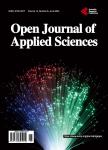Fabrication Parameter Optimization for a Multilayer Photovoltaic Cell Based on the Heterojunction: Zinc(II)-Meso-Tetrakis(4-Bromophenyl) Porphyrins/Fullerenes
Fabrication Parameter Optimization for a Multilayer Photovoltaic Cell Based on the Heterojunction: Zinc(II)-Meso-Tetrakis(4-Bromophenyl) Porphyrins/Fullerenes作者机构:Institut des Matériaux Jean Rouxel (IMN) Université de Nantes Nantes France Laboratorio de Electroquímica de Polímeros Departamento de Química Inorgánica Facultad de Química Pontificia Universidad Católica de Chile Santiago Chile Laboratorio de Polímeros Conductores Departamento de Química y Biología Universidad de Santiago de Chile Santiago Chile MOLTECH-Anjou Université d’Angers Angers France
出 版 物:《Open Journal of Applied Sciences》 (应用科学(英文))
年 卷 期:2013年第3卷第1期
页 面:136-144页
主 题:Conducting Polymers Phorphyrin Reactivity Photovoltaic Yield Anode Buffer Layer CuI MoO3
摘 要:The photoelectric properties of multilayer organic photovoltaic cells (OPV cells) were studied. The active organic layers consisted of a planar heterojunction between a layer of Meso-Tetrakis(4-BromoPhenyl) Zinc(II) Porphyrin (BrPhPZn) as electron donor (ED) and a layer fullerene molecules. The devices were fabricated in a high vacuum by thermal sublimation, a technique that allows multilayer devices realization easily by successive depositions, and it does not require solvents, achieving purer films with reproducible characteristics. Taking into account that the anodic contact, a key factor for cell efficiency, is favored by the inclusion of a thin anodic buffer layer (ABL), the effect on the yield after including one or two (ABL): MoO3 or MoO3-CuI layers was studied. The cell which has the best photovoltaic characteristics has a BrPhPZn (ED) thickness of only 12.5 nm. This small thickness is related with the low conductivity of this organic molecule. On the other hand, including a thin MoO3-CuI bilayer increased, such device’s efficiency in a 200%, with regard to a cell without ABL, getting for one cell ITO/MoO3-CuI/BrPhPZn/C60/Alq3/Al, with a 1.03% yield.



